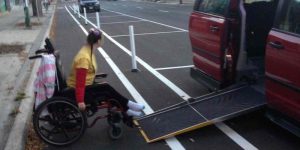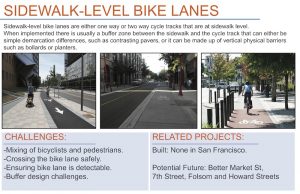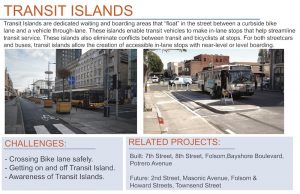Building a Better Bike Lane — for All
On the morning of March 6, over 50 people from San Francisco and Oakland — representing transportation advocacy groups, city agencies, and the disability community — joined Walk San Francisco and the Vision Zero Senior and Disability Workgroup for a 3-hour charrette to discuss new ways to design protected bike lanes that are safe and accessible for all pedestrians.
An absorbing topic, full of potential
Protected bike lanes are key to accomplishing our city’s Vision Zero goals: they protect bicyclists from fast-moving traffic and add a safety buffer for people on the sidewalk. At the same time, most protected bike lane designs obstruct direct curb access, which is a challenge for people with disabilities and seniors. These designs also require people getting on the bus or parking a car to cross a bike lane, adding a new point of potential conflict.
San Francisco is already a leader in designing bike lanes that are accessible for people walking, but they could be even better. The Vision Zero Senior and Disability Workgroup designed this charrette so that the people who bike and the people who are concerned about access could sit down with the city staff who design these bike lanes, to come up with new solutions that work for everyone. The principles of universal design — “design for all people regardless of their age, size, ability or disability”— helped inform our discussion.
Attendees broke into groups to dive deep into the challenges that various bike lane designs pose, including bike lanes protected by transit islands and/or parking, as well as sidewalk-level bike lanes. Everyone then got so caught up in talking about solutions that we had to force them to take a break!

 Challenges we discussed included:
Challenges we discussed included:
• Crossing the bike lane safely
• Paratransit access (paratransit must provide door-to-door service)
• Loading and unloading problems, including lack of accessible parking, narrow travel area from floating parking to curb, longer distances to access curb, etc.
• Detectability of transit islands by blind or visually impaired individuals
• Separation between bike lanes and sidewalks at the same level
By the end of the three hours, themes had started to emerge, including the need for more raised infrastructure and the need for more opportunities for people using and crossing the lanes, advocates, and city staff to collaborate on design.
Solutions
We talked about many interesting solutions. Two are pictured here (click on the images to see bigger versions): sidewalk-level bike lanes and transit islands.
Next steps
San Francisco attendees decided to meet again in six months, while answering some questions in the meantime, including: what further research do we need, who else should we include in the conversation, and how do we set up a useful and efficient design review process?
Oakland advocates and city staff who attended were eager to meet up sooner and to get a similar conversation started on their side of the Bay.
All in all, it was a day of connections, creativity, problem solving, and hope. The vision is clear: to make San Francisco a place where everyone of every age and ability can safely make their way through our streets.
For more, read the Streetsblog SF story about our charrette and what’s at stake, and stay tuned for further developments and progress.
Many thanks
Walk SF would like to thank the Vision Zero Senior and Disability Workgroup, the San Francisco Municipal Transportation Agency (SFMTA), and our excellent facilitators for helping design this workshop and making it a success.

